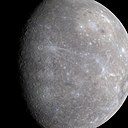Ficheiro:Mercury in color - Prockter07-edit1.jpg
Aspeto

Dimensões desta antevisão: 600 × 600 píxeis. Outras resoluções: 240 × 240 píxeis | 480 × 480 píxeis | 768 × 768 píxeis | 1 024 × 1 024 píxeis | 1 950 × 1 950 píxeis.
Imagem numa resolução maior (1 950 × 1 950 píxeis, tamanho: 734 kB, tipo MIME: image/jpeg)
Histórico do ficheiro
Clique uma data e hora para ver o ficheiro tal como ele se encontrava nessa altura.
| Data e hora | Miniatura | Dimensões | Utilizador | Comentário | |
|---|---|---|---|---|---|
| atual | 15h12min de 3 de junho de 2008 |  | 1 950 × 1 950 (734 kB) | Jjron | {{Information |Description={{Information |Description=Full color image of from first MESSENGER flyby |Source=NASA/JPL [http://messenger.jhuapl.edu/gallery/sciencePhotos/image.php?page=1&gallery_id=2&image_id=143] |Date=2008-01-30 |Author=NASA/[ |
Utilização local do ficheiro
As seguintes 3 páginas usam este ficheiro:
Utilização global do ficheiro
As seguintes wikis usam este ficheiro:
- ar.wikipedia.org
- المجموعة الشمسية
- عطارد
- كوكب
- بوابة:المجموعة الشمسية/مقالة متميزة
- ويكيبيديا:صور مختارة/الفضاء والكون/نظرة إلى الأعلى
- بوابة:علم الفلك/صورة مختارة
- ويكيبيديا:ترشيحات الصور المختارة/عطارد بالألوان
- ويكيبيديا:صورة اليوم المختارة/يناير 2018
- قالب:صورة اليوم المختارة/2018-01-13
- بوابة:علم الفلك/صورة مختارة/52
- بوابة:المجموعة الشمسية/مقالة متميزة/3
- ويكيبيديا:صورة اليوم المختارة/أغسطس 2021
- بوابة:كواكب
- بوابة:كواكب/كوكب مختار
- قالب:صورة اليوم المختارة/2021-08-24
- بوابة:كواكب/كوكب مختار/2
- قالب:صورة اليوم المختارة/2024-10-30
- ary.wikipedia.org
- arz.wikipedia.org
- ast.wikipedia.org
- as.wikipedia.org
- ay.wiktionary.org
- azb.wikipedia.org
- az.wikipedia.org
- Merkuri (planet)
- Planet
- Vikipediya:Həftənin seçilmiş məqaləsi/oktyabr 2016
- Vikipediya:Həftənin seçilmiş məqaləsi/42. Həftə 2016
- Portal:Günəş sistemi/Seçilmiş məqalə
- Portal:Günəş sistemi
- Vikipediya:Həftənin seçilmiş məqaləsi/sentyabr 2017
- Vikipediya:Həftənin seçilmiş məqaləsi/36. Həftə 2017
- Vikipediya:Həftənin seçilmiş məqaləsi/yanvar 2018
- Vikipediya:Həftənin seçilmiş məqaləsi/5. Həftə 2018
- ba.wikipedia.org
- bcl.wikipedia.org
- be.wikipedia.org
- bew.wikipedia.org
- bh.wikipedia.org
- bn.wikipedia.org
- btm.wikipedia.org
- ca.wikipedia.org
Ver mais utilizações globais deste ficheiro.




